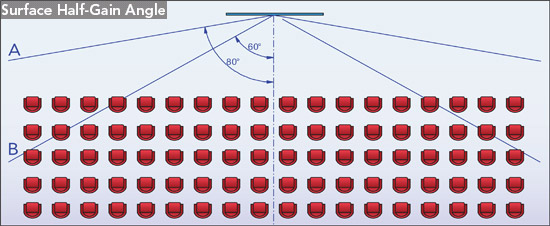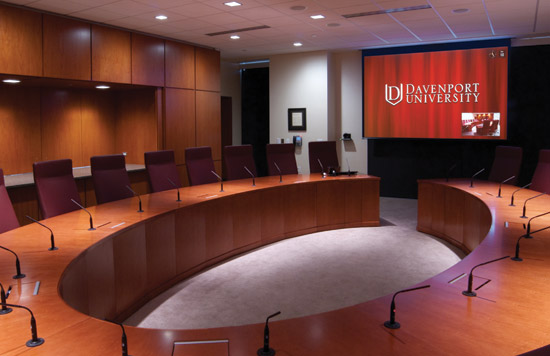Projection Screens Made Simple
Screen Surfaces
There are several variables which affect the selection of the proper screen surface for a given application. Each variable must be carefully considered.
The impact of screen tint should be considered when selecting a screen surface. As a rule of thumb, white surfaces are best for dark rooms and wide seating areas and grey surfaces are best for rooms with ambient light.
Matte white is a highly diffusive white surface with minimal ambient light rejecting properties.
Grey surfaces help to reject ambient light. These surfaces absorb more stray light with their darker tint, and help to improve the blacks on the screen. However, these surfaces benefit from more projected brightness since these darker surfaces absorb more whites and bright colors to improve blacks in the image. Selecting a brighter projector will compensate for this while still achieving the benefits of improved blacks.
High-performance screen surfaces are typically a dark grey tint to help absorb stray ambient light and deepen black levels even more than light grey surfaces. They typically reflect light from the projector back to the viewers, while reflecting off-axis ambient light away from the viewers. High-performance screen surfaces may also have a lens structure that can block off-axis ambient light from reflecting toward the viewers—this is most important when light fixtures in the ceiling have been mounted too close to the screen surface. It is always recommended to install light blocking shades at windows.
Retro-reflective surfaces are ultra reflective and typically have higher gains to help increase brightness of older model projectors. These surfaces are designed to reflect light directly back to the light source. They have very narrow off-axis viewing and can tend to hot-spot on many new model projectors.
Recyclable Material
Currently most screen materials are vinyl based and are not recyclable. However, screen materials are available that are recyclable, PVC free, and cradle-to-cradle certified. With many projects striving for LEED certification, specifiers should be aware of the more sustainable options.
Rear Projection Screens
System specifiers should note that flexible rear projection screens are attractive for retrofit projects, as the material can be rolled up, and the frame can ship in pieces for installation on site at reasonable cost. However, there are drawbacks. Designers must allow for proper pressure equalization between the audience space and the rear projection space so that when a door is opened or shut the screen surface does not bounce back and forth. Further, because the material is so thin, the projector fan noise may be heard from the audience, and there are comparatively fewer options in materials. White materials allow short throw distances for smaller spaces, but do not perform well in ambient light. Grey materials work well in ambient light, but need longer throw distances. Rigid materials available in either glass or acrylic, however, do not have issues with pressure equalization and because they are thicker, have good acoustic isolation. Because a film is applied to a substrate, rigid materials offer more choices—films can be customized in tint and combined with shades of glass or acrylic for even more options. These materials, however, are more expensive and unwieldy. Glass is used more widely than acrylic, as the latter is more susceptible to the effects of humidity and can bow. A new thinner “semi rigid” acrylic screen substrate can be rolled for shipment, solving some of the issues with delivery and installation of large rigid rear screens.
Screen Gain
Specifiers must also examine screen gain in selecting a proper screen material. Screen gain is a measure of brightness compared to light reflecting off a block of magnesium carbonate or barium sulfate. This serves as the industry's standard for a gain of 1.0. Screen surfaces typically have a gain of between 0.7 -3.0 depending on application. Screen gain can help increase brightness, but typically reduces off-axis viewing. Matte white is a very common choice with a screen gain of 1.0.
 |
|
Image courtesy of Draper Inc. |
A screen half gain angle is a material spec stating the angle off axis from the center perpendicular at which the image brightness becomes half that of straight on. In the accompanying diagram, material A has a half gain angle of 80°. But if more brightness is needed, material B, which has a half gain angle of 60°, covers the audience well, but steers more light into the primary viewing cone.
Throw Distance
Another consideration in optimal viewing is the projector throw distance, which is the distance from the screen surface to the projector lens. The throw distance ratio is the ratio between the throw distance and the image width and is also called the lens ratio which indicates the type of lens that may be needed with the projector. A typical throw distance ratio when using a projector with a “standard zoom lens” is approximately 1.8:1. Some model projectors can be ordered having various lenses with ratios ranging from 0.67:1 – 7.0:1.
Hot Spotting
There is a relationship between the gain of the screen surface and the projector throw distance ratio. If they are not matched properly, hot spotting could occur. “Hot spotting” means that the image appears overly bright in the center, and dark near the edges. In this situation, the light hitting the outside of the screen is at a shallow angle reflecting light away from the viewers so the outside of the image is less bright than the middle of the image, and a hot spot is created. A good rule of thumb to avoid hot spotting on a white screen is that the gain should never be greater than the throw distance ratio. Grey screens and high-performance screens require even longer throw distances due to their higher transmission of light to the viewer in both front and rear projection scenarios.
The problem is easily corrected by either dropping the screen gain or increasing the throw distance.
Lighting
In a projection system, it is important to look at ambient lighting in two places, at the screen and at the audience. Light hitting the screen washes out blacks and decreases the image contrast. Light in the viewers' eyes competes with projection light getting to the viewers eyes and determines how bright a system is needed.
The more light hitting the screen surface, the more the black in the image gets washed out, decreasing image contrast. Projectors cannot project black, which is the absence of light. They can only project white and color. The only way to get black on any screen is to have a dark room. Only grey and high-performance screens can help improve black in the image. A good target for a commercial application is to have no more than 5 foot candles of ambient light hitting the screen—if there is more, a matte white surface will have difficulty showing a good black. In this case, a grey or higher gain white surface should be considered. If more than 8 foot candles of ambient light hit the screen, a grey or higher gain white surface will have difficulty showing a good black, and a high-performance surface should be considered.
 |
In terms of proper lighting, less than five foot candles is best for commercial projection. Photo courtesy of Draper Inc. |
In most commercial projection applications it is advisable to have 30 foot candles of ambient light on the viewers so they can comfortably take notes or read handouts. Having too much ambient light on the viewer is not good for projection. When there is too much ambient light, the iris in the human eye begins to shut, letting less light in. The projected image will not look as bright. It is important that the amount of foot lamberts, or units of luminance, of projected light coming from the screen is always much higher than the amount of foot candles of ambient light on the viewers. Ambient light on the viewer should never compete with the projected light.









